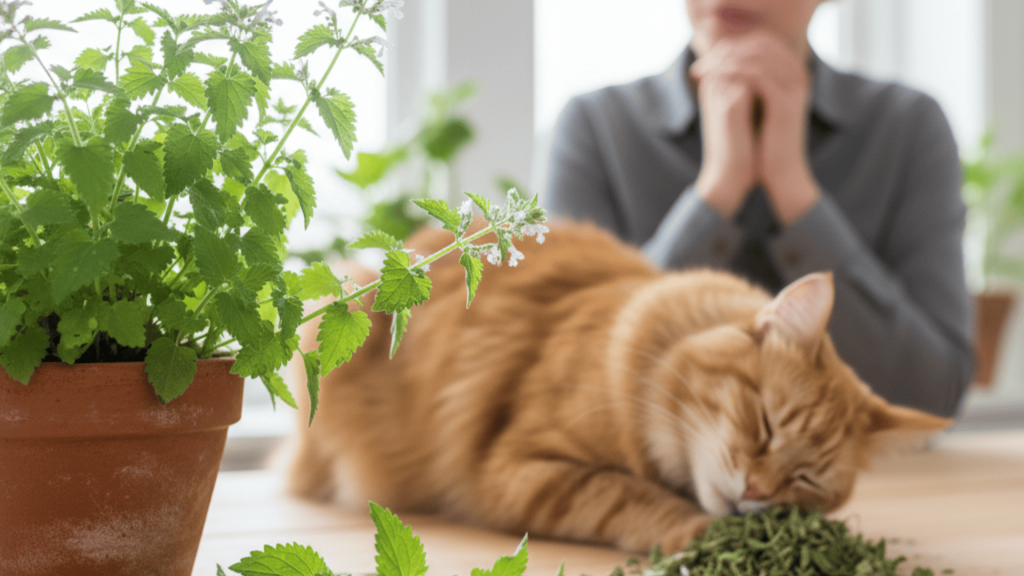I’ve been asked about smoking catnip more times than I’d expect, and I get why people are curious. We all know cats go absolutely wild for the stuff, so it’s natural to wonder if humans might experience something similar.
The short answer? You can technically smoke catnip, but don’t expect a cannabis-like high. Some people report mild relaxation, though the evidence is pretty thin.
What you’re really getting is the typical risks that come with inhaling any kind of smoke into your lungs.
I want to walk you through what’s actually in catnip, what limited research exists on its effects in humans, the health concerns you should know about, and some practical guidance if you’re still considering trying it.
What is Catnip & the Active Compound?
Catnip, or Nepeta cataria, is a perennial herb from the mint family that’s been used for centuries in herbal teas and as a natural insect repellent.
The active compound responsible for all the fuss is nepetalactone, found primarily in the plant’s leaves and stems. In cats, this chemical triggers intense behavioral responses by binding to receptors in their nasal tissue, causing that familiar rolling, rubbing, and general euphoria.
Humans, however, lack these specific receptors, which explains why we don’t experience the same dramatic effects.
The pharmacological data on nepetalactone’s impact on human physiology remain surprisingly limited, leaving us with more anecdotal reports than solid science.
How Do People Use Catnip?

People have found various ways to use catnip beyond just entertaining their feline friends. While it’s most commonly consumed as a soothing herbal tea, some apply it topically or burn it as an insect repellent.
There’s also a curious history of people smoking it, particularly during times when cannabis was harder to come by.
1. Brewed Tea
Catnip tea has been a traditional remedy for centuries, primarily used to promote relaxation and ease digestive discomfort.
People steep the dried leaves in hot water, creating a mild, minty beverage that’s generally considered safe for occasional consumption. Herbalists have recommended it for everything from relieving menstrual cramps to calming restlessness before bed.
The warm liquid itself adds to the soothing experience, making it difficult to separate the placebo effect from any genuine pharmacological action.
How It Affects: May produce mild sedation and digestive relief, though effects vary significantly between individuals.
2. Topical & Repellent Uses
Catnip’s essential oils have natural insect-repelling properties, making it useful as a mosquito deterrent when applied to skin or burned outdoors.
Some people also use it in poultices or salves for minor skin irritations, following traditional herbal medicine practices. The nepetalactone compound that drives cats crazy happens to be quite effective at keeping bugs away from humans.
How It Affects: Acts as a natural insect repellent; topical applications may provide minor anti-inflammatory benefits.
3. Smoking
During the counterculture movements of past decades, some people experimented with smoking catnip as a legal alternative to marijuana, hoping for similar psychoactive effects.
These attempts were largely driven by availability rather than evidence of efficacy. Anecdotal reports from that era vary wildly, with most users finding the experience underwhelming compared to their expectations.
How It Affects: Produces minimal to no psychoactive effects; primarily results in smoke inhalation risks without significant benefits.
What Happens If You Smoke Catnip: Evidence & Reports
The scientific literature on smoking catnip is remarkably sparse. Historical case reports from the late 1960s mentioned catnip in relation to “psychedelic compounds” and “alteration of consciousness,” Catnip: Its uses and effects, past and present – PMC, but these were isolated accounts without controlled studies to back them up.
Consumer health sites and clinical resources consistently emphasize that smoking catnip doesn’t produce a cannabis-like high.
Most people report either mild relaxation and drowsiness or absolutely nothing at all. The variability in these experiences suggests placebo effects may play a significant role.
Without rigorous human trials examining dosage, delivery method, and measurable outcomes, we’re left relying on anecdotal evidence that ranges from “slightly calming” to “complete waste of time.”
Smoking Catnip: Potential Immediate Effects
When people smoke or consume catnip, the effects are generally underwhelming compared to what cats experience. Most reactions are mild and short-lived, though individual responses vary considerably.
- Mild sedation or calming sensations, similar to drinking chamomile tea.
- Respiratory irritation, including coughing, wheezing, or sore throat from inhaling smoke.
- Headaches or feelings of general malaise, especially when consumed in high doses.
- Nausea or gastrointestinal discomfort may occur if taken in large amounts.
- Drowsiness or slight lightheadedness that may temporarily impair concentration.
The truth is, most people report feeling either nothing at all or just a whisper of relaxation that fades within half an hour.
In high doses, catnip can cause vomiting and a general feeling of being unwell, which explains why it never gained traction as a recreational substance despite occasional experimentation.
Main Health Risks of Smoking Catnip

Smoking catnip might seem harmless since it’s a natural herb, but combustion transforms any plant material into a cocktail of harmful substances.
The risks extend beyond the mild effects people chase, creating genuine threats to their respiratory and overall health.
1. Respiratory Harm from Smoke Inhalation
Smoking catnip delivers tar and fine particulates that irritate the throat and lungs, causing coughing and wheezing. The American Cancer Society warns that all smoke contains chemicals and toxins that can lead to cancer.
Combustion of any plant releases carcinogens that damage airways and alveoli, potentially increasing chronic respiratory disease risk over time.
Immediate Symptoms: Persistent coughing, chest tightness, wheezing, and throat irritation worsening with repeated use.
2. Unknown Toxic Byproducts from Combustion
Burning catnip creates unpredictable chemical reactions beyond simple nepetalactone inhalation. Combustion generates polycyclic aromatic hydrocarbons, volatile organic compounds, and particulate matter that can damage cellular DNA.
The essential oils turn into irritants whose long-term lung tissue effects remain unstudied. Research on nepetalactone combustion products and their accumulation effects is virtually nonexistent.
Immediate Symptoms: Variable respiratory discomfort, potential chemical burns in airways, unpredictable allergic responses
3. Dose-Dependent Systemic Effects
High catnip doses cause headaches, vomiting, and general illness, while smoking makes dosing impossible to control. Large amounts trigger gastrointestinal distress, including nausea and stomach upset.
The sedative effects can impair driving ability or machinery operation. Combining respiratory irritation with systemic effects creates compounding risks exceeding any potential benefit.
Immediate Symptoms: Headaches, nausea, judgment-impairing drowsiness, and possible vomiting with excessive use
Who Should Avoid Catnip?
Certain groups face heightened risks when using catnip, particularly when smoking it. If you fall into any of these categories, the safest approach is complete avoidance unless your healthcare provider specifically advises otherwise.
- Pregnant individuals should avoid catnip entirely as it may stimulate the uterus and cause miscarriage.
- Breastfeeding parents should stay away from catnip due to insufficient safety data for nursing infants.
- Children are particularly susceptible to adverse effects including stomach pain, irritability, and sluggishness.
- People with asthma, COPD, or any respiratory conditions must avoid inhaling smoke from catnip or any plant material.
- Anyone taking sedative medications or scheduled for surgery should avoid catnip as it can cause excessive drowsiness.
The bottom line is simple: if you’re vulnerable, skip the experiment. There are safer, better-studied alternatives for relaxation that won’t put you or a developing baby at risk.
Smoking vs. Drinking Catnip Tea: Comparative Safety
If you’re genuinely curious about catnip’s calming effects, the method of consumption matters significantly.
Tea has centuries of traditional use and documented safety profiles, while smoking introduces unnecessary respiratory risks with no proven advantages.
| Aspect | Catnip Tea | Smoking Catnip |
|---|---|---|
| Evidence Base | Historical documentation dating back to 1735; traditional doses established | Very limited research; mostly anecdotal reports |
| Safety Profile | Possibly safe in moderate amounts for most adults | Possibly unsafe; linked to impaired judgment and respiratory harm |
| Primary Effects | Mild sedation and relaxation; may help with nervousness | Minimal effects; fleeting calm lasting under 30 minutes |
| Side Effects | Drowsiness, upset stomach, headaches with excess use | Coughing, wheezing, nausea, carcinogen exposure |
| Dosage Control | Measurable doses allow predictable consumption | Unpredictable concentration; impossible to standardize |
| Overall Risk | Low risk when used appropriately; avoid during pregnancy | Cumulative lung damage from smoke and particulates |
The verdict is clear: if you’re seeking catnip’s potential calming benefits, tea is the safer, better-studied option. Smoking introduces avoidable respiratory risks without offering any documented advantage over oral consumption.
There’s simply no compelling reason to inhale combusted plant material when you can steep it safely in hot water instead.
Smoking Catnip: Common Myths & Misconceptions

The internet is full of wild claims about smoking catnip, and separating fact from fiction matters for your health. Let me clear up the most persistent myths so you can make informed decisions.
Myth 1: Catnip Gets Humans High Like Cannabis
Fact: Scientific research confirms that people do not get high on catnip, as it lacks THC, CBD, or other psychoactive compounds found in cannabis. The nepetalactone compound that triggers euphoric reactions in cats doesn’t have the same impact on human brain receptors.
Myth 2: Because It’s Natural, Smoking It is Harmless
Fact: All smoke carries tar and irritants that stress your lungs, even from natural herbs, and you’re still inhaling potentially cancer-causing chemicals. The American Cancer Society warns that all smoke contains particulates, chemicals, and toxins that can lead to cancer.
Practical Harm-Reduction Advice
I understand that despite all the warnings, some of you might still be curious about trying catnip. While I strongly recommend against smoking it, here’s some practical advice to minimize potential harm if you proceed.
- Only use organic, pesticide-free catnip to avoid inhaling harmful chemicals; never smoke products meant for pets.
- Start with catnip tea instead, using proper doses of dried herb in hot water to test your tolerance safely.
- If you choose to smoke, minimize frequency and avoid deep inhalation to reduce lung exposure.
- Never mix catnip with tobacco, cannabis, or alcohol as combining substances increases unpredictable risks.
- Seek immediate medical care for persistent cough, difficulty breathing, severe headache, vomiting, or any allergic reactions.
Remember, harm reduction isn’t endorsement; it’s acknowledging reality while prioritizing your safety.
The safest choice remains avoiding smoking altogether and exploring tea or other non-inhalation methods if you’re interested in catnip’s mild effects.
That’s a Wrap
After examining the science and safety concerns surrounding catnip, I hope I’ve given you a clear picture of what smoking it really entails.
The bottom line? It won’t get you high, it carries genuine respiratory risks, and there are far safer ways to experience its mild calming effects if that’s what you’re after.
Tea remains your best bet if you’re curious about catnip’s traditional benefits. Your health matters more than experimentation with questionable rewards.
If you’ve tried catnip or have thoughts on herbal alternatives, I’d love to hear your experience in the comments below. Stay safe and informed out there.









